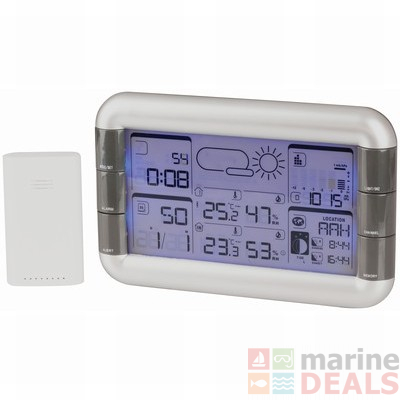

Ambient Weather provides the most comprehensive mounting solutions for your weather station.
Perform a Site Survey. Always perform a site survey to determine the transmission distance. Have this information handy if you need to contact the manufacturer or dealer.
Wireless vs. Cabled. Wireless is far easier to install than cabled weather stations. Consider an Integrated Sensor Suite (all of the sensors integrated together in one package) and a tripod mounting kit (most stations include U-Bolt mounting hardware to connect to a mast or pole).
Never install a wireless weather station in a structue with aluminum siding or roof - metal acts as a shield.
Weather Stations are rated 'Line of Sight'. Transmitting through earth or soil (down a hill), through water or other physical barriers may significantly limit transmission.
Make sure your wireless weather station is communicating to all of the sensors before installing the station. If a sensor is not communicating, reset the main console and try again.
Wireless weather stations also provide more installation options. You can add multiple consoles and multiple sensors available from Ambient Weather.
Rooftop vs. Ground Mounting. If you are going to install a weather station on a roof, be careful. Injuries, roof leakage and lightning strikes can occur for roof mounted installations. We recommend a professional roofer assist you in the installation.
In general, we recommend mounting the anemometer at least 6' above the roof line.
For ground installations, the rule of thumb is to install the weather station at a distance of 4 times (4x) the height of the nearest building (or any wind obstruction). For example, if your building is 25 feet tall, and your anemometer is 5' off the ground, install the weather station at a distance of 80 feet, or:
Distance = 4 x (Obstruction Height - Anemometer Installed Height)
Distance = 4 x (25' - 5') = 80'.
Of course, this is rarely practical unless you live at the airport, and often times, you must install the weather station or anemometer on a rooftop.
Lightning. Direct or indirect lightning strikes may damage your weather station, even with lightning arrestors installed. In lightning prone areas, install a lightning rod, and connect the mast to earth ground, and consider contacting a licensed electrician. Cabled weather stations can result in significant damage if the path of least resistance is inside the home through the console. If your weather station is damaged, you may be covered by your home owner's insurance.
Birds and Rodents. For wired installations, it is recommended you run the cables in electrical conduit. Rodents chew through the wires. Birds will excrement and nest in your rain gauge. Mount your rain gauge in an open area. You may want to install a decoy owl or spike strip around the rain gauge.
Calibrating your Wind Direction. Wind direction must be calibrated to true North. A compass or GPS is required to calibrate the wind direction. Consider a digital compass or GPS for improved accuracy. To calculate the difference between magnetic north and true north for your location (magnetic declination), link here. You need to know your longitude and latitude first based on your address link here.
Calibrating the Barometric Pressure. To compare pressure conditions from one location to another, meteorologists correct pressure to sea-level. Because the air pressure decreases as you rise in altitude, the sea-level corrected pressure (the pressure your location would be at if located at sea-level) is generally higher than your measured pressure. Thus, your pressure may read 28.62 inHg (969 mb) at an altitude of 1000 feet (305 m), but the corrected pressure is 30.00 inHg (1016 mb). The standard sea-level pressure is 29.92 in Hg (1013 mb).
Pressure conditions greater than 29.92 inHg (1013 mb) are considered high pressure and less than are considered low pressure. To calibrate your barometer, locate a National Weather Station (NWS) station near you, and adjust the barometric pressure offset to match the calibrated weather station. For real-time weather information in your area, visit Weather Underground.
Best Wireless Weather Station
View and Download DigiTech XC-0366 user manual online. Wireless Weather Station With Outdoor Sensor. XC-0366 weather station pdf manual download. A highly advanced weather station with an unbeatable range of features to keep you fully updated on current and future atmospheric activity. The outdoor sensors are simple to install and will wirelessly transmit data to the base station which interprets and displays the data on the touch screen panel. It's hardwired into my PC which is on 24/7 and data is recorded using weather display which works with a number of different weather stations – i ditched the software that came with the station in favour of this. Build a custom weather station with the sensors that fit your needs. Our best-selling weather stations track temperature, humidity, rainfall, lightning and more. WiFi weather stations and Weather Underground connections make weather monitoring easy.